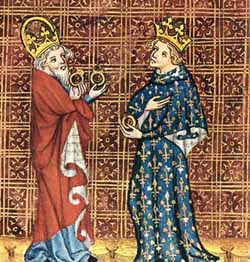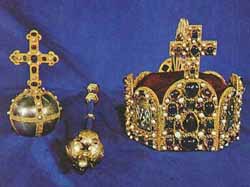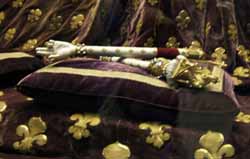 |
What People Are Commenting
Pagans, Regalia & Friendship
Pagans & Buddhists
TIA,
The word pagan meaning a rustic was Roman army slang for a civilian. To call a Buddhist a pagan means that you are calling him or her a rustic and, what is more important, a person who does not engage in warfare. In fact you are paying all Buddhists a compliment by calling them pagans!
T.D.

Royal Regalia

|
Dear TIA,
Your site, with other Traditional sites, are always both inspirations and aggravations to me. Inspirations in the accounts of the glories of the Catholic past (and future) in the lives and teaching of the Saints and of its society and culture. Aggravations in the telling of the shenanigans, both in word and deed, of the Novus Ordo (a term I prefer because the soul and substance, indeed, the purpose and existence, of the Church, or "church" is determined and expressed in the Mass). For that reason, I always try to prepare to pray the Rosary by reading TIA and other such sites.
Today, in reading the meditation on the life of St. Louis, I followed the link to the article on "The Symbol of the Sword in Today's Defense of the Church", which prompted a very brief observation and a question, both of which I would like to share with you for your correction and comments.
First, the observation: In the illustration of The Father shown in the article on the sword, He is pictured, as traditionally, as an old man with white hair and beard. Modernists, those "promoters" of tolerance and understanding, often (always?) ridicule this image as childish anthropomorphism, and use it to justify their accusations that God is just a human construct and not a Self-Revealed Entity.
However, if they were honest scholars, they would - for the sake of tolerance and understanding - spend the time and effort to learn the most basic principles of Christian iconography, both Eastern and Western. Then they would know that the white hair and beard are not intended to be literal depictions of Him, but rather, to express His infinite Wisdom and role as The Father. (It would not surprise me to find out that many of them do know this, but ignore it because it does not fit their strategy and purpose.)
Now, the question: Has anyone connected with TIA studied the symbolism of regalia, particularly that connected with coronations, and its relationship to Catholic Faith and Culture? I suspect such a study would be of most enlightening and enjoyable. Would it be possible for TIA to post such studies in the future?
As always, my prayers and kindest thoughts go with you.
Novus Ordo delenda esto [the new Mass must be destroyed],
J.M.

TIA responds:
Dear Mr. J.M.,
Thank you for your high consideration and deep support. They are a much appreciated reward for the work we do.
We are taking your interesting suggestion into account, and will be looking for a study on the regalia used in the coronation of sovereigns. When we will find a complete explanation on the topic, we will inform our readers.

Above, the Emperor, a crown closed by an arch, meets the King of France, an open crown. Below first row, the crown, orb and scepter of the Holy Roman German Empire. Second row, the hand of justice and the scepter of the Kings of France


|
Without any pretension of being an exhaustive answer, here are some elementary points of symbolism that may help your research.
The crown and the scepter represent the royal or imperial power. They symbolize the sovereign power in the temporal sphere, that is to say, the legitimate King - after his coronation - becomes the highest authority in the civil order of his country. When the crown is open on the top, as is the crown of a King, it represents that his sovereign power still has the temporal authority of the Emperor over him. When the crown is closed, as that of the Emperor, it symbolizes that no temporal authority exists above his.
The orb or globe symbolizes that the body over which the sovereign exerts his power is an ensemble closed upon itself. It is a perfect society, that is, it is a self-sufficient society having in itself all the necessary means to attain its proper end. Since this end should be directed to the glory of God, normally atop the orb there is a richly elaborated Cross.
The hand of justice symbolizes sovereign's power to make laws and exercise justice. It translates practically as the right to rule, enforce the law, judge and apply sentences.
The sword symbolizes the right and duty to defend the kingdom against its external and internal enemies, as well as to defend the Catholic Faith against heresies.
The ceremony of coronation is conducted by the Catholic Church so that the sovereign may realize that all power comes from God; and even though the temporal sphere of a kingdom is a perfect society, it must rely on another perfect society, which is the Church. The latter should inspire and orient the former in all things that concern the eternal salvation of souls and the glory and exaltation of the Our Lord Jesus Christ and His Church.
These are some elementary points we pass on to you until we find more scholarly information.
Cordially,
TIA correspondence desk

Enlightening and Uplifting

|
Dear TIA,
I found the comments of Dr. Marian Horvat on the "The Nature of True Friendship" very edifying. It was a very clear exposition on the subject and I look forward to her further thoughts on this subject.
In my own schooldays and in Catholic schools and institutions up to the 1960s, "particular friendships" were discouraged and indeed forbidden. As Children of Mary we were warned that such friendships might cause cliques to be formed and in any case, we must preserve as much of our hearts as possible for love of God. To assist us, our places in class were changed occasionally throughout the term, and even in the dormitory we were relocated to different beds a couple of times each year.
In the Industrial School [where I worked] there was very close supervision to ensure cliques or factions were not formed and on a number of occasions, girls who were deemed to be "close" were separated by being sent to different institutions. In retrospect I imagine the nuns, in their wisdom, were only too aware of the potential danger of close relationships to the morals of girls of teenage years.
Generally in those days, there was a discreet and modest distance kept even between "friends." I believe there is far too much familiarity today among young people who seem to hug and embrace at even the hint of "friendship." This has I believe, much to do with the "democratization of manners" which is not a good thing.
Yours faithfully
C.M.

Posted December 10, 2008

The opinions expressed in this section - What People Are Commenting -
do not necessarily express those of TIA

Related Topics of Interest
 Pagan Divinities Honored in a Catholic church Pagan Divinities Honored in a Catholic church
 St Louis, Warrior and Saint St Louis, Warrior and Saint
 St. Clotilde and the Coronation of Clovis St. Clotilde and the Coronation of Clovis
 Coronation of Charlemagne Coronation of Charlemagne
 The Coronation Feast for Holy Roman Emperor The Coronation Feast for Holy Roman Emperor
 Explanations on Religious Symbolism Explanations on Religious Symbolism
 Symbols of the Papacy Symbols of the Papacy
 Groups of Friends and Guilds Groups of Friends and Guilds
 Married Persons and Friends of the Opposite Sex Married Persons and Friends of the Opposite Sex


|
Comments | Questions | Objections | Home | Books | CDs | Search | Contact Us | Donate

© 2002-
Tradition in Action, Inc. All Rights Reserved
|
 |
|